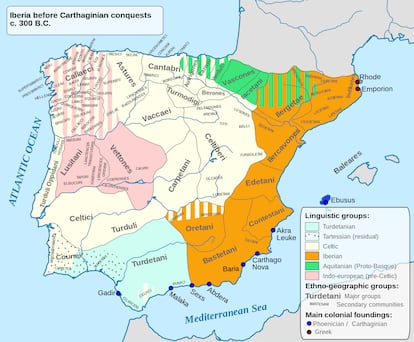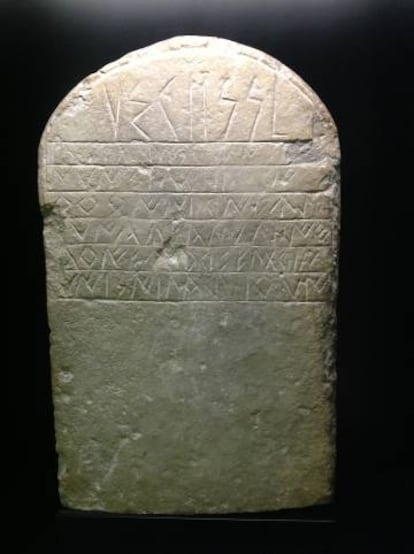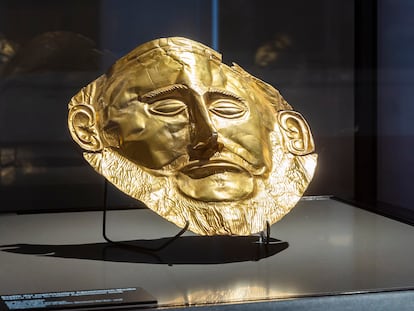The incredible art of translating pre-Roman languages without a Rosetta Stone
In the mid-20th century, Spanish epigrapher Manuel Gómez-Moreno deciphered the writing of the peoples of Hispania, making it possible to read inscriptions, such as the recently found Hand of Irulegi


Jean-François Champollion (1790–1832) is considered to be the father of modern Egyptology and has gone down in history for being the first to decipher hieroglyphic writing, in 1822. He did so thanks to the Rosetta Stone, a single text in three languages (hieroglyphic Egyptian; demotic writing, which was typical of the priestly caste; and Greek), which was found in 1799 during the Napoleonic campaigns in Egypt. For this reason, the brilliant French epigrapher is remembered in many articles, books, studies, films, documentaries, statues and street names. The same cannot be said of Spanish epigrapher Manuel Gómez-Moreno (1870-1970), who deciphered pre-Roman writings in the mid-20th century without a Rosetta Stone; he was armed only with notebooks and pencils. But now his name is back in the spotlight after the recent discovery of the so-called Hand of Irulegi near Pamplona, Spain. The Hand of Irulegi dates back to 2,100 years ago and features 40 characters written in the Proto-Basque language. Professors Javier Velaza and Joaquín Gorrochategui have translated the first word of the inscription, sorioneku, which means good omen. But how were they able to figure out its meaning?
The five great languages – Lusitanian, Celtiberian, Iberian, Proto-Basque and Tartessian – that were spoken when the Romans landed on the Iberian Peninsula in 218 BC can be read and interpreted thanks to epigraphers such as the Marquis of Valdeflores (1722–1772), Gómez-Moreno and Antonio Tovar (1911–1985), although many doubts and unknowns remain. Martin Almagro Gorbea, a former professor of Prehistory and specialist in Iberian protohistory, sums it up this way: “Currently, we only debate whether a text says, ‘this is so-and-so’s stele’ or it should be translated instead as ‘here so-and-so is buried.’ And, to a large extent, we owe this [knowledge] to Gómez-Moreno, the great Spanish epigrapher.”

The Iberian Peninsula has always been a kind of reservoir of Indo-European and non-Indo-European languages. As the continent’s Finisterre and, therefore, at a remove from the great western migratory flows, its languages remained archaic and didn’t change much. The Iberian Peninsula was divided into two large land masses, the Atlantic and the Mediterranean. But Hispania’s inhabitants were strongly connected for commercial reasons, meaning that many of them were likely bilingual. For example, in the winter, herds of Celtiberian transhumant (nomadic) shepherds from the north grazed in the southern Tartessos or Gadir, an eminently Mediterranean city.
The Celtiberian transhumant shepherds from the north reached the southern Tartessos, which forced them to be bilingual
In the third millennium BC, Indo-European peoples from Ukraine and southern Russia penetrated the Baltic, generating northern Europe’s Germanic languages, while those who moved westward gave rise to the Celtic languages. The fact that these people carried the R1b genetic group – which, for example, allowed them to assimilate milk proteins as adults and accumulate large reserves of ferritin, facilitating their survival and expansion – led researchers to follow their linguistic trail in Hispania and Europe. As a result, scholars have determined that Proto-Celts settled in a mosaic pattern throughout the Iberian Peninsula’s Atlantic area; the language that linguists call Lusitanian came with them. Two millennia later, when writing appeared, Lusitanian’s idiomatic imprint was visible from the north of the peninsula to the Sierra Morena in south-central Spain.

On the other hand, the Iberian language was spoken in the Iberian Peninsula’s Mediterranean areas. The language came from Anatolia (Turkey) and spread throughout the western Mediterranean in the fifth millennium. It predominated in the Spanish Levant, Jaén and Eastern Andalusia, where it coincided with the Argar and proto-Tartessian cultures, which had their own language, Tartessian (in the region of Huelva, in southwestern Spain, and southern Portugal). Through contact in the northern part of the peninsula, the Iberian language was also related to Proto-Basque, although the latter may also be interconnected with Proto-Sardinian.
In 1200 BC, people from a Celtic culture known as the urnfield culture – so named because of their custom of cremating their dead and burying them inside vessels in large necropolises – arrived through the eastern passes of the Pyrenees. They expanded into the area of the high Jalón (Zaragoza), the Iberian System, Soria and Guadalajara. These people are known as Celtiberians, a group that prevailed over the older Celts who had been settled in these areas of the Iberian Peninsula for centuries. Thus, their language, Celtiberian, is closely related to Europe’s Celtic languages; however, because of its geographical location, the language did not evolve as much as the related Gaulish Celtic and Gaelic Celtic did. Celtiberians, who were cattle breeders, then moved toward the west of the peninsula and linguistically absorbed the other Iberian peoples in those areas, such as the Vacceans and the Vetons, who were Celtiberianized. The Celtiberians extended as far as an imaginary line between present-day Astorga (in the north) and Mérida (in western Spain, in Extremadura).
To the west of that strip of land, the Lusitanians maintained their Indo-European language in present-day Galicia, Portugal and Extremadura. Like Spanish, this language had just five vowels. Only a hundred words from this language, which is halfway between Celtic and Italic, have been preserved, so translating it remains difficult. It is possible that the language split when Celtic and Italic had not yet differentiated during the first migrations. Unlike the rest of the Iberian peoples, the Lusitanians only began to write after the Roman legions conquered them. In fact, there are some inscriptions by Lusitanian priests with ritual instructions that have a prologue in Latin. Spanish epigrapher Antonio Tovar identified this language in the 1950s.

In contrast to the Lusitanians, Iberian elites did know how to write; they took writing from the Tartessians – with whom they maintained commercial relations – in the 6th century BC, who had adapted it from the Phoenicians around the 8th century BC. This alphabet developed a semi-syllabic system, which consists of writing vowels and liquid and nasal consonants with a single symbol, and it also uses a single symbol for occlusive syllables (a syllabic system). Iberian writing is divided into southern (Andalusia, Murcia and Alicante) and Levantine (from Valencia to Roussillon, France) variants.
For their part, the Celtiberians copied the Iberians’ writing; it is practically the same with only a few variations. The discovery of the Hand of Irulegi – which consists of 40 symbols – shows that the Proto-Basques adopted the Celtiberians’ writing, with some variations to reproduce characteristic Proto-Basque sounds. The Basque language was spoken to the south of the Pyrenees, between Jaca and Navarre, as far as Aquitaine (in southern France). The language was not spoken in the present-day Basque Country, where the inhabitants communicated with each other in Celtic, as the names of geographical features – for example, Deva and Nervion – demonstrate. The language now known as Euskadi only became linguistically Basque during the Middle Ages; for that reason, the territory has been referred to as the Vascongadas, the lands that became Basque.
But how is it possible to translate all these languages without a Rosetta stone? In the 18th century, the Marquis of Valdeflores, Luis Joseph Velázquez de Velasco y Cruzado, was the first to identify the Celtiberian language. He wrote a treatise on its symbols based on the coins he identified at the time. But the real breakthrough came from the studies of Manuel Gómez-Moreno. He compared the inscriptions of the Celtiberian coins with Roman ones from the same city, and the name of the town written on the two coins made it possible for him to compare the two scripts and understand the symbols. In any case, his great contribution was to discover the semi-syllabic system (an alphabet composed of letters and syllables). Tovar would unravel the Lusitanian alphabet years later.
Gómez-Moreno compared the inscriptions of Celtiberian coins with Roman ones to find similarities
In his Monumenta Linguarum Hispanicarum, German Jürgen Untermann (1918–2013) compiled a lexicon of all the words from the Iberian Peninsula that had been deciphered. We know one hundred Lusitanian words, a few dozen Tartessian words (because almost no inscriptions have been found in that language), and around a thousand words each of Iberian and Celtiberian.
But how many of these words do we understand? “We can comprehend 80% of the Celtiberian and 60% of the Iberian words. Experts are certain about very few Tartessian words because they disagree about whether it is an Indo-European language combined with ancient elements. We also understand 60% of the Lusitanian words. However, these figures do not mean that we know that percentage of the languages [as a whole], but rather the percentages we can understand of the texts that we have found,” explains Martín Almagro.
Experts are currently trying to further their knowledge through artificial intelligence. “First, the corpora [databases of identified words] are being compiled. Once we have them, they will be entered into computers. There are linguists working on it, but if you don’t have the data, you can’t make progress. Archaeology is behind in this [respect]. We are still looking for coins by looking at them in books. The logical thing [to do] would be to put them in a scanner and find parallels,” Almagro says.
For those who are interested in learning more, there’s a database (hesperia.ucm.es) that includes everything that linguists know about Tartessian, Celtiberian, Iberian and Proto-Basque. It is free to access, and through its maps, one can find and read everything that is known about the inscriptions that have been found. The database does not include translations, but it does provide descriptions of the objects (from coins to tombstones) with the words engraved on them and the archaeological context in which they were found.
Sign up for our weekly newsletter to get more English-language news coverage from EL PAÍS USA Edition
Tu suscripción se está usando en otro dispositivo
¿Quieres añadir otro usuario a tu suscripción?
Si continúas leyendo en este dispositivo, no se podrá leer en el otro.
FlechaTu suscripción se está usando en otro dispositivo y solo puedes acceder a EL PAÍS desde un dispositivo a la vez.
Si quieres compartir tu cuenta, cambia tu suscripción a la modalidad Premium, así podrás añadir otro usuario. Cada uno accederá con su propia cuenta de email, lo que os permitirá personalizar vuestra experiencia en EL PAÍS.
¿Tienes una suscripción de empresa? Accede aquí para contratar más cuentas.
En el caso de no saber quién está usando tu cuenta, te recomendamos cambiar tu contraseña aquí.
Si decides continuar compartiendo tu cuenta, este mensaje se mostrará en tu dispositivo y en el de la otra persona que está usando tu cuenta de forma indefinida, afectando a tu experiencia de lectura. Puedes consultar aquí los términos y condiciones de la suscripción digital.
More information
Últimas noticias
Maduro pleads not guilty before the federal court in New York: ‘I am still the president of Venezuela’
A new test can detect Alzheimer’s from a finger prick
UN team enters Sudanese city of El Fasher after paramilitary massacre: ‘It’s like a ghost town’
A recipe for resistance: Indigenous peoples politicize their struggles from the kitchen
Most viewed
- Gilles Lipovetsky: ‘If you want to live better and fall in love, take Prozac, don’t look to philosophy’
- Alain Aspect, Nobel laureate in physics: ‘Einstein was so smart that he would have had to recognize quantum entanglement’
- Alvin Hellerstein, a 92-year-old judge appointed by Bill Clinton, to preside over Maduro’s trial in New York
- Why oil has been at the center of Venezuela-US conflicts for decades
- Maduro’s downfall puts China’s relationship with Venezuela to the test









































